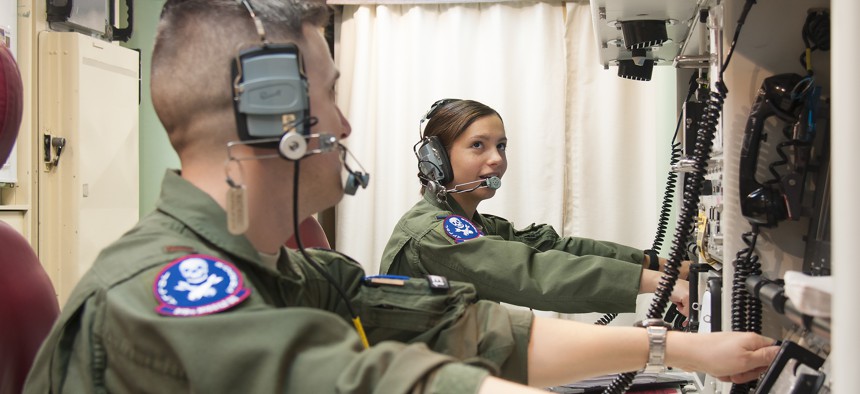
First Lt. Pamela Blanco-Coca and 2nd Lt. John Anderson, simulate key turns of the Minuteman III ICBM in a Launch Control Center on the F.E. Warren Air Force Base Missile Complex in Wyoming. USAF Senior Airman Jason Wiese
Nuclear Command Network Would See Comprehensive Upgrade Under Trump Plan
While the ICBMs, bombers, submarines and cruise missiles get lots of attention, the network connecting them also needs updating.
For all the talk of new ICBMs and small nuclear weapons, the decades-old communications network that would enable U.S. commanders’ hurried pre-launch conversations and the launch orders themselves is in more dire need of an upgrade.
The Trump administration is expected to call for widespread updates to the nuclear network of satellites, aircraft, ground stations and control centers, according to a draft of the Pentagon’s Nuclear Posture Review, which the Huffington Post posted on Thursday. That’s in addition to calling for new, low-yield nuclear weapons and submarine-launched cruise missiles.
This year’s posture review — at least according to the draft; the official version is to be released within weeks — will be the first to put in place a comprehensive plan to upgrade the nuclear command, control, and communications network, dubbed NC3.
"The United States must have an NC3 system that provides control of U.S. nuclear forces at all times, even under the enormous stress of a nuclear attack," the review says. "NC3 capabilities must assure the integrity of transmitted information and possess the resiliency and survivability necessary to reliably overcome the effects of a nuclear attack."
While all the upgrades will likely take more than a decade, the draft report more immediately calls on Gen. Joseph Dunford, chairman of the Joint Chiefs of Staff, to come up with a plan by May 1 to reform oversight of the nuclear network and its updating, since it spans multiple services and organizations.
The Air Force oversees a large portion of the nuclear command-and-control apparatus, to include early-warning satellites and radars, communications satellites, airborne command planes and the terminals inside ICBM launch centers and nuclear bombers. The Navy has its own command planes and terminals inside its ballistic missile submarines.
The nuclear network hasn’t been largely upgraded in nearly three decades, according to the draft review. While it "remains survivable and effective," some parts of the network date back to the 1960s.
"Of particular concern are expanding threats in space and cyber space, adversary strategies of limited nuclear escalation, and the broad diffusion within [the Defense Department] of authority and responsibility for governance of the NC3 system, a function which, by its nature, must be integrated," the draft of the review states.
Some parts of the NC3, however, are already being upgraded. A 2015 report by the General Accountability Office looked at seven related projects and found that “while the programs and efforts have made progress toward developing and fielding systems as well as meeting cost, schedule, or performance goals, known capability gaps or deficiencies remain. For example, development of key satellite communication terminals for strategic bomber aircraft has been deferred by several years.”
Gen. David Goldfein, the Air Force chief of staff, characterized the nuclear network as “reliable but fragile.”
“It gets to a point where it’s going to be hard to continue to upgrade and keep those platforms airborne at the level of reliability that we need,” Goldfein told Defense One in October after touring Air Force and Navy nuclear command-and-control planes at Offutt Air Force Base in Nebraska.
“Making sure that we get the nuclear enterprise right to defend the nation, it really is job one. That’s beyond mere words,” he said. “The world is a dangerous place and we’ve got folks that are talking openly about use of nuclear weapons. It’s no longer a bipolar world where it’s just us and the Soviet Union. We’ve got other players out there who have nuclear capability. So it’s never been more important to ensure that we get this mission right.”
The new system must be protected from cyber and space-based threats, according to the draft of the report. It must also have improved command posts and communications links — a reference to the command planes flown by the Air Force and Navy that would transmit the nuclear codes from the president to the ICBMs, bombers and submarines. The Pentagon this year is expected to take the first steps in replacing these so-called “doomsday planes.”
The Congressional Budget Office estimates it will cost $184 billion over the next 30 years to update the nuclear network.




